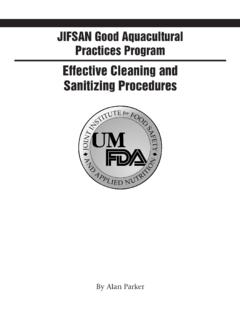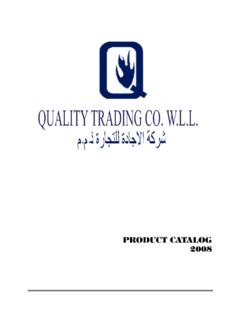Transcription of Green Cleaning, Sanitizing, and Disinfecting: A Curriculum ...
1 Green cleaning , sanitizing , and Disinfecting: ACurriculumforEarly Care and EducationThis Green cleaning , sanitizing , and disinfecting Toolkit for Early Care and Educationwasdeveloped by the University of California, San Francisco School of Nursing s Institute for Health& Aging, University of California, Berkeley s Center for Environmental Research and Children'sHealth, and Informed Green Solutions, with support from the California Department ofPesticide cleaning , sanitizing , and disinfecting : A Toolkit for Early Care and EducationAcknowledgmentsWe gratefully acknowledge the input of the many individuals who took the time to review the documents in this Collaborative to Improve Indoor Air Quality in Early Care and Education (ECE) Facilitiesprovided expert, engaging,and wide-ranging discussion of the issues presented here. We particularly thank the California Department of PesticideRegulation (DPR) for funding this second Toolkit. Main ContributorsVickie Leonard, RN, PhD,School of Nursing, Institute for Health & Aging, University of California, San Francisco (UCSF)Carol Westinghouse, Informed Green Solutions, VermontAsa Bradman, PhD,Center for Environmental Research and Children's Health, School of Public Health, University of California (UC), BerkeleyAdditional ContributorsJesse Erin Berns,UC Berkeley School of Public Health; Alex Blumstein.
2 Lynn Rose, Environmental ConsultantAdditional ReviewersALLIANCE TEAM PARTNERSJ ennifer Flattery, MPH, Occupational Health Branch, California Department of Public HealthDennis Jordan, Certified Industrial Hygienist,Alameda County Healthy Homes DepartmentJudith Kunitz, Health Coordinator, Unity Council Children & Family Services, Oakland, CAJenifer Lipman, RN, NP, Head Start-State Preschool, Office of Education, Los Angeles CountyBelinda Messenger, PhD, California Department of Pesticide Regulation (DPR)Bobbie Rose, RN, Child Care Health Consultant, the California Childcare Health ProgramAnn Schaffner, MS, California Department of Pesticide Regulation (DPR)Justine Weinberg, MSEHS, Certified Industrial Hygienist, Occupational Health Branch, California Department of Public HealthOUTSIDE REVIEWERSPhil Boise, Green Care for Children Amber Brunskill, Lyn Garlingand Michelle Niedermeier,PennsylvaniaIntegrated Pest Management, Penn State University Ellen Dektar,Alameda County LINCC Project Peggy JenkinsandJeff Williams,California Air Resources Board Jerome Paulson,Professor of Pediatrics and Environmental &Occupational Health, George Washington University Nita Davidson,DPR Rebecca Sutton,Environmental WorkingGroup Melanie Adams, Kathy Seikel, Bridget Williams,and Carlton Kempter, Environmental Protection Agency(EPA)
3 Joan Simpson,Environmental & Occupational Health Assessment Program, Connecticut Department of PublicHealth Jason Marshall,Toxics Use Reduction Institute, UMass Lowell Nancy Goodyear,UMass Lowell Debbie Shrem,Occupational Health Branch, California Department of Public Health Graphic Design:Robin Brandes Design, :Noa P. Kaplan, :Vickie Leonard, Editing:Joanna Green , Citation:UCSF Institute for Health & Aging, UC Berkeley Center for Environmental Research and Children'sHealth, Informed Green Solutions, and California Department of Pesticide Regulation. Green cleaning , sanitizing , andDisinfecting: A Toolkit for Early Care and Education,University of California, San Francisco School of Nursing: San Francisco, California, Information:These materials can be reproduced for non-commercial educational purposes. To requestpermission to copy this Toolkit in bulk, contact Vickie Leonard at for this project has been provided in full or in part through a grant awarded by the California Department ofPesticide Regulation (DPR).
4 The contents of this document do not necessarily reflect the views and policies of DPR, nordoes mention of trade names or commercial products constitute endorsement or recommendation for use. 2013 UCSF Institute for Health & AgingThis Toolkit is dedicated to the Early Care and and Education (ECE) programproviders, custodial staff and children who live and work in ECE facilities across theUnited States. ECE staff work tirelessly to care for our nation s children. We hope thatthese materials will contribute to healthier ECE environments and to improved healthfor those who spend time in cleaning , sanitizing , and disinfecting : A Toolkit for Early Care and EducationTable of ContentsIntroduction1 Why should we change the way we clean, sanitize, and disinfect?1 What is the difference between Cleaning, sanitizing , and disinfecting ?2 Children are more sensitive to the health effects of toxic chemicals2 What this Toolkit includes3 Section 1: What is infectious disease?4 There are different kinds of germs4 Germs: The good side5 How do germs get into our bodies?
5 61. Direct contact62. Droplets63. Airborne transmission64. Fecal-oral transmission75. Blood76. Insect bites8 Why do some people get sick and others do not?8 Why are ECE programs the perfect environment for the spread of infectious diseases?8 How are infectious diseases treated?9We can also reduce the spread of germs by our behaviors9 One last thought on the role of infectious disease in health9 Section 2: Why is it important to clean in ECE?10 Children are more vulnerable10 More reasons to clean in ECE10 Section 3: What are the health hazards of cleaners, sanitizers, and disinfectants?12 Government regulations require only limited labeling of cleaning products12 Acute and chronic health effects12 What is asthma?13 Some common chemicals and their effects14 What are endocrine disruptors?14 Improper use of cleaning , sanitizing , and disinfecting chemicals can increase exposure and health risks15 The endocrine system15 Aerosols16 Using cleaning , sanitizing , and disinfecting products without good ventilation16 How do we prevent these health hazards?
6 16 Section 4: Effects of cleaning , sanitizing , and disinfecting products on the environment17 Triclosan in the environment17 Fragrances in the environment18 Section 5: What is the difference between cleaning , sanitizing , and disinfecting , and how do these tasks help control infectious disease in ECE?19 Cleaning19 Sanitizing19 Disinfecting20 What are the recommendations and requirements for sanitizing and disinfecting ?21 sanitizing and disinfecting requirements and recommendations comparison chart22 Section 6: Personal practices for reducing the spread of infectious disease in ECE24 Behavioral strategies that can reduce the spread of infectious disease 251. Cough and sneeze etiquette252. Isolation/social distancing253. Vaccinations254. Equipment255. Ventilation266. Air filtering and cleaning equipment26 Section 7: Choosing safer products for cleaning , sanitizing , and disinfecting28 Third-party certifiers: A way to identifysafer cleaning products 28 Ingredients to avoid29 Choosing safer sanitizers30 Choosing safer disinfectants30 Group buying31 Safety Data Sheets31 Section 8: Clean isn t a smell!
7 32 Health effects of fragrance chemicals in air fresheners and fragranced cleaners, sanitizers, and disinfectants32 Air fresheners33 Are "natural" air fresheners any safer?33 How to avoid fragrances and their health effects33 Section 9: What are the most effective and safest ways of cleaning , sanitizing , and disinfecting in ECE?34 Routine cleaning34 Tools for cleaning34 Carpeting tips35 cleaning products and procedures35 Surface cleaning36 Floor cleaning36 What not to use and why37 Carpet cleaning37 cleaning tips37 Diluting concentrated products38 Sanitizing38 Tools for sanitizing38 Products and procedures for sanitizing39 sanitizing food preparation areas using a chemical sanitizer39 Hand washed dishes39 Automatic dishwashers39 Mouthed toys and pacifiers40 Electronics/keyboards40 Disinfecting40 Tools for disinfecting41 Products and procedures for disinfecting41 Hard surfaces (drinking fountains, toilets, floors 42 Section 10: What is a Hazard CommunicationProgram?)
8 43 Where does the Hazard CommunicationStandard apply?43 What does the Hazard Communication Standard require?43 Safety Data Sheets (SDSs) for hazardous products44 Label requirements for containers of hazardous products44 Information and training44 The Hazardous Materials IdentificationSystem (HMIS )45 Section 11: What is the most effective and safest way to clean body fluids and blood spills in ECE?46 Body fluid spills (BFSs) on porous and nonporous surfaces46 What is a spill kit?47 Glossary48 Resources51 AppendicesAppendix A:Model Green cleaning , sanitizing , and Disinfection Policy for ECE Programs54 Appendix B:Tips on Forming a Buying Cooperative56 Appendix C:How to Hire a cleaning Service57 Appendix D: What, Where, and How Often to Clean, Sanitize, and Disinfect in ECE58 Appendix E: Model Center Hazardous Communication Program Policy60 Table of ContentsGreen cleaning , sanitizing , and disinfecting : A Toolkit for Early Care and EducationIntroductionThis Green cleaning , sanitizing , and DisinfectingToolkit will help you make changes in your earlycare and education (ECE) program so you canbetter maintain your facility while also reducinginfectious disease.
9 The Toolkit presents practicalinformation on how to ukeep ECE environments clean and safeusing practices and products that are lesshazardous to health and the environment; uprotect young children and staff frominfectious care of young children provides idealconditions for the spread of infectious in ECE get sick more often, and arehospitalized more often when they do get sick,compared to children cared for at home. Parentsmust also take time off from work to care for shows that there are several steps thatcan reduce the risk of infectious disease in ECE: uDevelopment of written policies forreducing the risk of infectious disease uEducation of child care center staff aboutinfection control practices that is repeatedon a regular basis, preferably every year when new products or policies are introduced when new employees are hired uCareful and frequent handwashing by bothstaff and children uAppropriate cleaning and targeteddisinfection of contaminated surfaces whennecessary uSeparation of food preparation, toileting,and diaper changing activities uVaccination of children and staffWhy should we change the way we clean,sanitize, and disinfect?
10 ECE programs prevent infectious disease by usingcleaning, sanitizing , and disinfecting products. Inthe past, little thought was given to the risksposed by these products. Many people mistakenlythink that if a cleaning , sanitizing , or disinfectingproduct is sold to the public it has been reviewedand proven safe by government agencies. The Protection Agency (EPA) requiresthat products labeled as sanitizers or disinfectantsdo kill the germs that the product claims to kill,but the registration review does not evaluate allpossible health risks for users of the products are also not routinely reviewedby the government to identify health risks to theuser. Some manufacturers choose to have the EPAevaluate their cleaning products for human healthand environmental safety through the Design forthe Environment (DfE) Safer Product LabelingProgram, but this is voluntary and most productsare not are constantly learning more about thepotential health problems of cleaning , Sanitizing, and disinfecting products.















